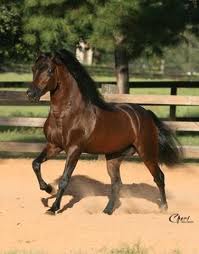RARE COLOR PATTERNS FOR ANDALUSIAN HORSES

The wind of heaven is that which blows between a horse's ears. ~ Arabian Proverb
Tuesday, June 26, 2012
Sunday, May 13, 2012
ANOTHER GYPSY VANNER PONY
GRONINGEN HORSE
Here's an unusual horse. It's a Groningen. Ever heard of it? Me neither. (I guess it's German, considering the name.)
Do you like it?
Do you like it?
GYPSY VANNER PONY
Labels:
feathering,
Gypsy Vanner,
long manes,
long tails,
ponies,
strong
Wednesday, April 11, 2012
MORE CAROL WALKER PICTURES
Friday, March 23, 2012
TRIO OF PASO FINOS
Labels:
even-gaited,
Paso Fino,
smooth ride,
South America
Saturday, March 10, 2012
HERD OF FRIESIANS
Most Friesians are black; but there are also wonderful pintos. I've never met one, but hope to one day. Sounds like a truly wonderful breed! (Don't you love the long manes and tails?)
EXMORE PONIES
They have striking features, different than other ponies and horses. One of them is that they have a 27th molar which other horses lack.
They are sturdy, and, although considered an old breed, some British consider them valuable for the running of their farms.
The male Exmoor is very kind when he seeks out his mate. He may go a long way to find her, but when having done so, he is patient and does not cause trouble.
Exmoors are very similar to cave paintings of horses. They are prized by many individuals in Great Britain.
Pictures of Exmoors are not easy to find. Exmoors seem to be related to ancient horses, but no DNA proof has validated that. Yet they remind us of cave paintings.
They are stout, strong, patient and heavy bearing pack animals. If you are lucky to have one, cherish it's heritage. They have been close to extinction several times.
Labels:
ancient breed,
cave paintings,
Exmoor,
extinction,
patient,
ponies,
strong
FRIESIAN FOLLIES
- The Emperor Charles (reigned 1516 -56) continued Spanish expansion into the Netherlands, which had its Frisian warhorse, noted by Vegetius and used on the continent and in Britain in Roman times. Like the Andalusian, the Frisian bred true to type. Even with infusions of Spanish blood during the sixteenth century, it retained its indigenous characteristics, taking the best from both breeds. The Frisian is mentioned in 16th and 17th century works... a courageous horse eminently suitable for war, lacking the volatility of some breeds or the phlegm of very heavy ones. Generally black, the Frisian was around 15hh with strong, cobby conformation, but with a deal more elegance and quality. The noted gait was a smooth trot coming from powerful quarters. Nowadays, though breed definition is retained, the size has markedly increased, as has that of most breeds due to improved rearing and dietary methods. --WIKIPEDIA
 The Friesian also remains popular as a carriage horse, as it is a powerful horse and its high-stepping action is eye-catching. It is particularly popular in competitions that require the driving of a team, partly because of its movement and disposition, and partly because it is easy to match teams of black horses. Friesians are also good all-around horses, used for showing, driving, and general riding, and are also used as circus horses.
The Friesian also remains popular as a carriage horse, as it is a powerful horse and its high-stepping action is eye-catching. It is particularly popular in competitions that require the driving of a team, partly because of its movement and disposition, and partly because it is easy to match teams of black horses. Friesians are also good all-around horses, used for showing, driving, and general riding, and are also used as circus horses.Due to its flashy appearance, the Friesian has become popular in the film industry. Though Friesians are of dramatic appearance, sometimes their use in dramatizations of actual historical events is of dubious accuracy, given that the breed as it is known today only came into being within the last 400 to 600 years. The breed owes much of its current popularity to the appearance of the Friesian stallion Goliath (real name: Othello) in the 1985 film, Ladyhawke, which ignited a worldwide interest in these horses. Films such as Eragon, The Mask of Zorro, Alexander, The Chronicles of Narnia, and The Wolfman have also featured Friesian horses. An episode of the TV series Lost featured a Friesian/Saddlebred cross. Most recently Friesians were seen in the 2010 remake of Clash of the Titans, where two horses named "Boech" and "Gallo" each took turns playing the winged horse, Pegasus, and they were also used in the 2011 remake of Conan the Barbarian. --WIKIPEDIA.
Subscribe to:
Comments (Atom)

























































